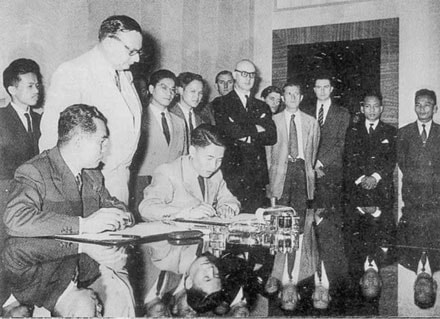Professor Ta Quang Buu and the country's military science
(Baonghean.vn) Professor Ta Quang Buu was born on July 23, 1910 in a Confucian family in Hoanh Son village, Nam Hoanh commune, Nam Dan, Nghe An province.
Growing up in a studious and studious family, Professor Ta Quang Buu soon had the consciousness to study hard to help the country. In 1922, he took the entrance exam to Hue National School and ranked 11th in the school. After that, he was transferred to Buoi School to continue his studies. In 1929, after passing the Vietnamese Baccalaureate and finishing first in the Spanish Baccalaureate in Mathematics, he received a scholarship to study abroad (the Association for the Promotion of Education of

Professor Ta Quang Buu, Deputy Minister of National Defense, in the Vietnamese Government delegation signed the ceasefire agreement to restore peace in Vietnam.
In August 1945, he went to Hanoi to join the revolution. After taking power back to the people, our State was in great need of patriotic intellectuals to participate in important positions of the Government. Therefore, from September 1945 to January 1946, he was assigned to be the Foreign Minister of the Provisional Government of the Democratic Republic of Vietnam, Deputy Minister of National Defense.
During the days when the whole country was preparing for resistance, implementing the policy of peace with France to expel 200,000 Chiang Kai-shek troops back to the country, President Ho Chi Minh assigned him to draft many documents in foreign languages and sent him to participate in a number of diplomatic meetings to negotiate with France. In 1946, he participated in two important meetings: the Dalat Conference and the Vietnam Conference.
During the resistance war, he worked with the Government delegation in the Viet Bac War Zone. Here, in August 1947, he was admitted to the Communist Party and assigned to the position of Minister of National Defense. A year later, to create conditions for the professor to combine scientific research, he returned to the position of Deputy Minister of National Defense but was still a member of the Supreme Defense Council and Chief of the Central Military Commission Office. Although holding many important positions, the professor still took the time to impart his knowledge to generations of students right in the war zone. During the difficult years, lacking everything in the war zone, he continuously introduced to readers many valuable books such as: Shooting down aircraft with concentrated rifles. This book was very necessary because at that time we did not have anti-aircraft guns and other types of anti-aircraft guns; while there were many rifles and their planes flew very low. The book was quickly widely disseminated everywhere and many places shot down French planes.
In 1954, after the victorious Dien Bien Phu Campaign, the professor joined the delegation of the Government of the Democratic Republic of Vietnam to attend the Geneva Conference on Vietnam as Deputy Minister of National Defense and as the representative of the Commander-in-Chief of the Vietnam People's Army, signing the document of the Armistice Agreement in Vietnam and Laos.
Returning to Hanoi, Professor Ta Quang Buu was appointed as Principal of Hanoi University of Science and Technology (1956 - 1961), and concurrently Vice Chairman and General Secretary of the State Science Committee.
From 1965 to 1976, the professor was the Minister of Universities and Vocational Secondary Schools. During this period, Professor Ta Quang Buu still participated in solving the most pressing problems in military science and technology. In addition to supplementing and recalculating the formula for shooting down aircraft with infantry rifles during the anti-French period to apply in the destructive war of the US imperialists in the years 1965-1973, to be able to shoot down US jet planes, the professor also directly researched two other important major topics. The reason was that in the summer of 1972, US President Nixon ordered the dropping of mines on rivers and seas and blockaded Hai Phong Port, the professor directly directed a research team to design and manufacture mine-clearing equipment (codenamed GK1) to counter the US MK52 strategic mines and coordinated to solve the problem of defusing magnetic bombs (codenamed GK2) with Dr. Vu Dinh Cu as the team leader. The two scientists regularly exchanged experiences and successes in these two topics, contributing to the North's victory over the US's destructive war.
In recognition of the professor's great contributions, our Party and State have awarded him many medals: First Class Independence Medal, First Class Resistance Medal, First Class Victory Medal, First Class Resistance Medal against the US, First Class Feat of Arms Medal, Third Class Glorious Soldier Medal... He passed away in 1988. In 1996, the professor was posthumously awarded the Ho Chi Minh Prize, Phase I, for Science and Technology with the Collection of Modern Technical Works (after 1945) and many other achievements. The above-mentioned works of the professor achieved the basic scientific foundation of a number of fields and directly directed the technical work of clearing bombs and mines blocking the Gulf of Tonkin, Hai Phong; directed other important technical tasks in the country's war against the US. In addition, he also contributed ideas to orient the development of a number of basic sciences; viewpoints on building a practical and advanced national university and vocational secondary school sector...
The Party Committee, army and people of Nghe An are proud of an outstanding scientist, a devoted revolutionary soldier, who contributed his whole life to the cause of liberating, building and defending the Fatherland, always looking towards his beloved homeland!
Hoang Chinh
